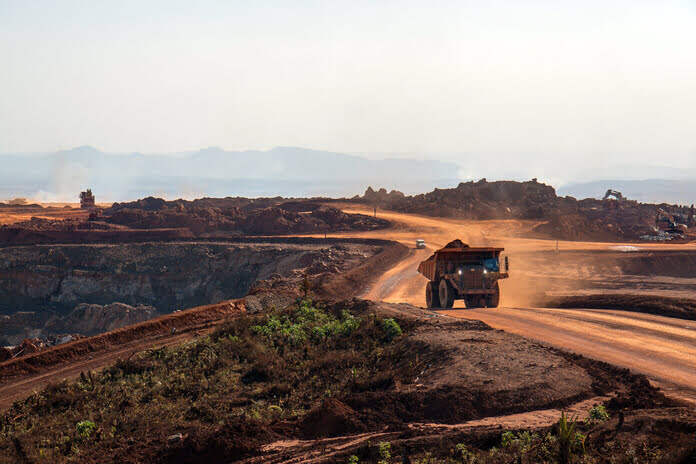China Is Still Crucial to Iron Ore Exports
One of the commodities that did the worst in 2022 was iron ore. Key factors pushing iron ore prices were down worries about Chinese macroeconomic performance and problems associated with Covid-19. About two-thirds of the world’s demand for iron ore shipped by sea comes from China.
Since the second quarter of 2022, China’s economic growth has slowed, mostly due to severe Covid regulations that have impacted port and land transportation, retail sales, and catering and prompted temporary shutdowns of plants in several important industrial areas. As the limitations were lifted, the sluggish local economy and rising foreign prices affected manufacturing in the fourth quarter of 2022. In addition, it has been difficult for real estate developers to get financing for housing developments.
According to the most recent official data, China’s GDP grew by 3% last year, the second-slowest rate since the 1970s. This came after the fourth quarter showed no gain. Our China economist has raised its GDP growth forecast for 2023 to 5% on the heels of a stronger-than-anticipated fourth quarter of 2022. That’s not to say things won’t get worse before they get better; recessions in the United States and Europe are probable this year, and China still confronts other significant obstacles.
In our November Commodities forecast, we predicted that iron ore prices would move in response to China’s handling of any further Covid outbreaks and the size of the stimulus package the Chinese government would announce.
Since this report’s publication, most Covid precautions have been lifted. On January 8th, overseas visitors no longer needed to enter a quarantine area because of a lowered threat level. Iron ore prices have been relatively stable so far in 2023 because of China’s unexpected departure from its zero-Covid policy and rising reopening optimism.
Also, Beijing has increased governmental assistance for its struggling real estate market in recent weeks. China’s latest action is to relax borrowing ceilings and extend the grace period for reaching debt objectives, allowing certain property businesses to increase leverage. It would loosen the “three red lines” guideline that had led to a record property slump and lowered demand for industrial metals.
Almost 40% of China’s annual steel usage comes from the construction industry. Since March, when cities in China started to implement a sales restriction, the industry has been in a steady decline due to the ongoing tightening of housing policies throughout the country.
Even though the government has increased its stimulus for the real estate market, the results have been tardy. In December, housing sales in China remained at a record low. Preliminary data from China Real Estate Information Corp. shows that in December, new house sales for the top 100 real estate developers fell 30.8% from a year earlier to 677.5 billion yuan ($98.2bn). That was a drop from November’s total of 25.5%.
We anticipate that the National People’s Congress in March will reveal further stimulus and infrastructure investment, further increasing commodity demand.
Demand in China Is Expected to Rise Again in 2023
According to Qu Xiuli, vice chairwoman of the China Iron and Steel Association (CISA), demand for iron ore and steel in China is likely to increase this year. She said that demand would increase in 2023 at a Beijing industry conference, owing to the impact of efforts to stabilize the economy and the ongoing optimization of Covid-19 preventive and control measures.
CISA estimates that China produced one billion tonnes of crude steel in 2018. This is down 2.3% from 2021.
Meanwhile, CISA statistics revealed that major Chinese steel mill stockpiles fell to their lowest since January last year. According to a study conducted by CISA, stocks dropped to 13.1 million tonnes in the last 10 days of December, representing an 18% decrease from stocks in the second 10 days of the month. Over the last week of December, crude steel output at major mills dropped 2.4% to 1.92 million tonnes per day.
Increased Profits May Be Limited by Government Oversight
The recent volatility in the price of iron ore has attracted the attention of authorities, who have issued warnings. In a statement released earlier this month, the National Development and Reform Commission expressed extreme worry about recent price increases and promised to keep a close eye on the issue. The government agency also warned against spreading misleading market data and committed to continuing rigorous price monitoring. In the past, governments have intervened in the market by limiting trade and mandating reductions in steel production capacity. We may be forced to revise our assessment downward if we see similar measures utilized again.
Beijing’s Growth-friendly Policy Will Help Iron Ore Prices
The growth-friendly policies implemented by Beijing are likely to keep iron ore prices at current or higher levels. The prospect of China’s reopening has led us to raise our iron ore prediction for 2023. Due to the normal slowdown in steel production around the Chinese New Year holidays later this month, we continue to exercise caution for the first quarter. We now anticipate prices to linger around $115/t in 1Q.
We anticipate a price increase to $120/t in the second quarter and $135/t in the third quarter (usually building season in China), with a slight decrease to $120/t in the fourth quarter.
Featured Image: Freepik @ wirestock















